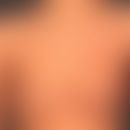Synonym(s)
HistoryThis section has been translated automatically.
DefinitionThis section has been translated automatically.
Not uncommon, complex, epidermal nevus, which often appears for the first time as a flat brown spot after intensive exposure to the sun. In the first years a certain size growth is often still observed. Hypertrichosis of the Becker nevus occurs later, not before puberty.
You might also be interested in
Occurrence/EpidemiologyThis section has been translated automatically.
In a larger study of American recruits between 17 and 26 years of age (n=19,302) a prevalence of 0.52% was found.
ManifestationThis section has been translated automatically.
In the rarest cases congenital occurrence. Mostly occurring in the 2nd or 3rd decade of life. Males are preferentially affected; m:w=6:1. gradual growth in size in later years of life. Hypertrichosis only postpubertal (androgen dependence?).
LocalizationThis section has been translated automatically.
Clinical featuresThis section has been translated automatically.
Sporadic, unilateral, (mostly) solitary, uniformly light brown to dark brown, only slightly increased in consistency, of varying size (ranging from palm-sized to almost half a half of the trunk) plaque with "archipelagic" reticulated loosening of the border zone and a usually strikingly prominent follicular pattern. A combination with smooth muscle hamartomas (see leiomyoma below) is not uncommon. In case of mechanical irritation a prominent goose skin appears as a sign of the underlying proliferated smooth muscle.
Initially there is a barely perceptible, but over the years increasing and clinically conspicuous hypertrichotic character of the lesion (especially in men), which may dominate the clinical picture.
Very rare is multiple occurrence (duplicity does not exclude the diagnosis).
Furthermore, a (rare) variant without pigmentation and/or hypertrichosis may occur, multiple piloleiomyomas, which are then called smooth muscle hamartomas.
Becker-Naevi in the female sex are rare. They are also much less conspicuous, since hypertrichosis is only slightly prominent.
Associated symptoms (very rare) are muscular and skeletal defects (scoliosis, funnel chest, spina bifida, etc.) see below Becker-Naevus-Syndrome)
HistologyThis section has been translated automatically.
Irregular, clumsy alteration of the retelephages of the hyperpigmented epithelium; papillomatosis; subepithelial individual melanophages as a sign of pigment incontinence; not infrequently a fibrosis of the dermis as well as an increase in smooth muscle strands is detectable.
Differential diagnosisThis section has been translated automatically.
The Becker nevus resembles the cafe-au-lait stain, but differs from it in the reticulated fringe areas and the frequent hypertrichosis.
Naevus spilus: This is similar to the cafe-au-lait stain or the Becker naevus. It differs from both, however, by the darker cracks in the underlying brown spot. The term "Lapwing-Egg-Naevus" describes this aspect very well.
Atrophodermia idiopathica et progressiva: Rarely only single but mostly multiple. No reticulated (broken) margin (smooth rim). Manifestation at a much later age.
Mongol stain: Color grey-blue to blue; congenital and not acquired; tendency to regression in the first two decades of life (opposite development to Becker-Naeuvs), no hypertrichosis (exclusion criterion); localization (shoulder region) is atypical.
TherapyThis section has been translated automatically.
Not required for medical reasons.
If necessary shave or bleach the hair
Alternative: Non-ablative laser therapy. Continued permanent depilation using laser techniques.
Progression/forecastThis section has been translated automatically.
Note(s)This section has been translated automatically.
LiteratureThis section has been translated automatically.
- Adam B et al (1988) Keratosis pilaris perforans in a Becker's melanosis. Nude Dermatol 14: 96-98
- Balaraman B et al.(2016) Hypertrichotic Becker's nevi treated withcombination 1,550 nm non-ablative fractional photothermolysis and laser hair removal. Laser Surg Med 48:350-353.
- Becker SW (1949) Diagnosis and treatment of pigmented nevi. Arch Dermatol Syphilol (Chicago) 60: 44-65
- Becker SW (1949) Concurrent melanosis and hypertrichosis in distribution of nevus unius lateris. Arch Dermatol Syphilol (Chicago) 60: 155-160
- Copeman PW (1965) Pigmented hairy epidermal nevus (Becker). Arch Dermatol 92: 249-251
- Greve B et al (2003) Medical dermatologic laser therapy. A review. dermatologist 54: 594-602
- Happle R et al (1997) Becker nevus syndrome. At J Med Genet 68: 357-361
- Lapidoth M et al (2014) Hypertrichosis in Becker's nevus: effective low-fluence laser hair removal. Lasers Med Sci 29:191-193
- Momen S et al(2016) The use of lasers in Becker's naevus: An evidence-based review. J Cosmet Laser Ther 18:188-192.
- Pectas SD et al. (2014) Becker nevus syndrome presented with ipsilateral breast hypoplasia. Indian J Dermatol 59:634
- Rao AG (2015) Bilateral Symmetrical Congenital Giant Becker's Nevus: A Rare Presentation. Indian J Dermatol 60:522.
- Ro YS et al (2005) Linear congenital Becker's nevus. Cutis 75: 122-124
Incoming links (20)
Becker melanosis; Becker-naevus syndrome; Café-au-lait stain; Current melanosis and hypertrichosis in distribution of nevus unius lateris; Epidermal nevus organoid; Hair follicle ectopes; Hair follicle nevus; Hunter's disease; Hyperpigmentation, circumscribed; Hypertrichosis, congenital circumscripts; ... Show allOutgoing links (7)
Atrophodermia idiopathica et progressiva; Becker-naevus syndrome; Café-au-lait stain; Epidermal nevus (overview); Laser; Leiomyoma (overview); Mongolian spot;Disclaimer
Please ask your physician for a reliable diagnosis. This website is only meant as a reference.
























